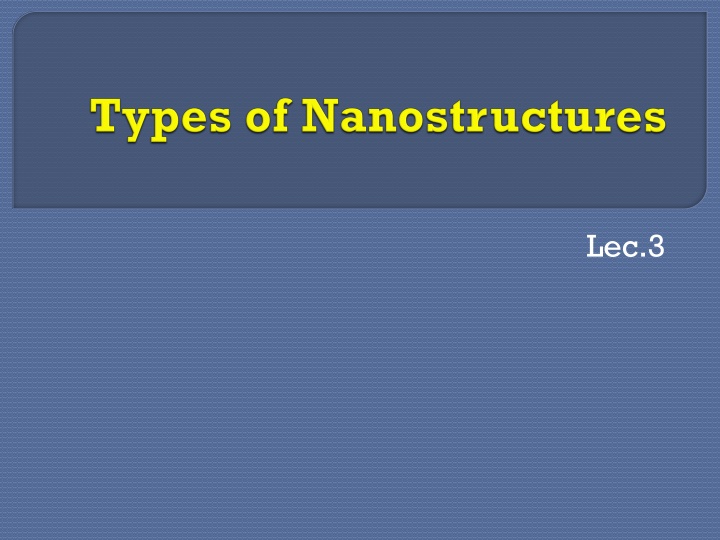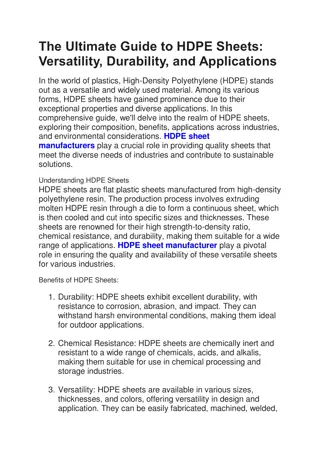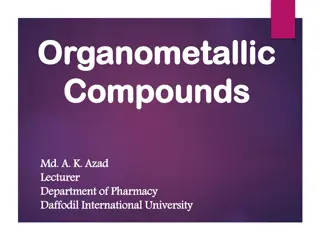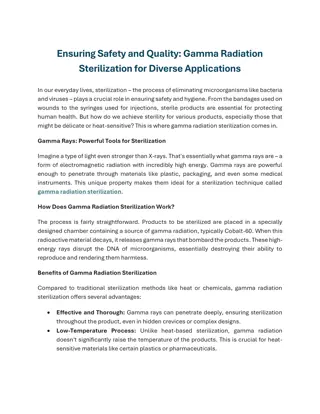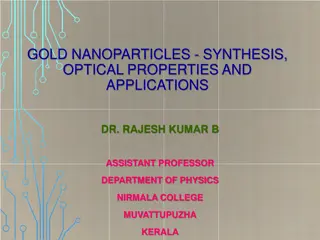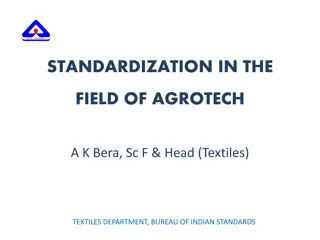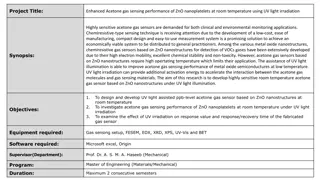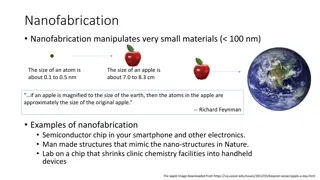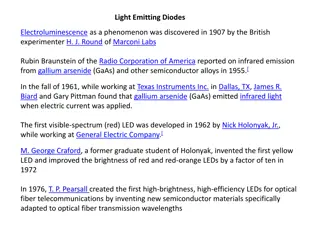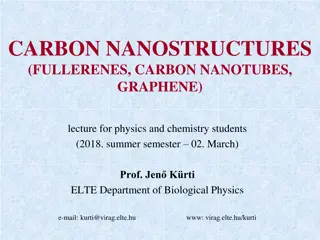Nanostructures and Their Diverse Applications
Nanostructures are objects at the nanometer scale with unique properties. Metallic NPs offer flexibility, while colloidal gold and silver NPs are promising in nanobiotechnology. Metal oxide NPs exhibit unique chemical properties and polymer nanoparticles have various applications. Carbon nanotubes (CNTs) have exceptional properties and applications in electronics and biomedicine.
Download Presentation

Please find below an Image/Link to download the presentation.
The content on the website is provided AS IS for your information and personal use only. It may not be sold, licensed, or shared on other websites without obtaining consent from the author.If you encounter any issues during the download, it is possible that the publisher has removed the file from their server.
You are allowed to download the files provided on this website for personal or commercial use, subject to the condition that they are used lawfully. All files are the property of their respective owners.
The content on the website is provided AS IS for your information and personal use only. It may not be sold, licensed, or shared on other websites without obtaining consent from the author.
E N D
Presentation Transcript
Nanostructures- objects with nanometer scale Made by human. Individual nanostructures come in a range of different forms including: clusters, nanoparticles, nanocrystals, quantum dots, nanowires, nanotubes, nanofibres, nanodots, and aggregated dendritic forms which are often three dimensional spherical in shape.
In general most agree that three things are important in nanostructures: 1. Small size, measured in 100 of nanometers or less. 2. Unique properties because of the small size. 3. Control the structure and composition on the nm scale in order to control the properties.
Compared with other nanostructures, metallic NPs have been proven to be the most flexible nanostructures owing to the synthetic control of their size, shape, composition, structure, assembly, and encapsulation, as well as the resulting turnability of their optical properties. By Dr.Neihaya Heikmat Zaki
Compared with other metallic nanostructures, colloidal gold and silver NPs are especially promising in nanobiotechnology because of their simple and fast preparation and able to bioconjugation.
Metal oxide NPs can exhibit unique chemical properties due to their limited size and a high density of corner or edge surface sites. Metal oxide particles serve many functions in the various field of plant technology and others. By Dr.Neihaya Heikmat Zaki
The term polymer nanoparticle is given for any type of polymer NPs but specifically for nanospheres and nanocapsules. These are obtained from synthetic polymers, such as polyacrylate. or natural polymers, albumin, DNA, chitosan, and gelatin. By Dr.Neihaya Heikmat Zaki
*CNTs, most simply, are molecules of carbon. CNTs display extraordinary mechanical, electronic, and optical properties. *One of the key advantages of CNTs is their strength. *CNTs are expected to have huge applications in nanometer-sized electronics and other biological and biomedical application.
Nanoclay:a clay consisting of nano-sized particles. There are two origins of nanoclay, firstly, the in situ alteration of volcanic ash, and secondly the hydrothermal alteration of volcanic rocks. there is interest to use it in food packaging applications such as to make transparent containers and covering films.
The structure of the nanoclay particles can be divided into two main groups, platelets and nanotubes.
Quantum dots are one of the most interesting nanotechnology developments. About 1 to 6 nanometers in diameter, a quantum dot is a nano-sized semiconductor crystal,and are so small that they are also known as artificial atoms. Quantum dots have a range of remarkable electrical, magnetic, optical, and catalytic properties.
Quantum dots are spherical or cubic-like in shape and are made up of thousands of atoms. With highly luminous quantum dots, doctors are able to identify cancerous tissue in vivo by using a Mercury lamp. The quantum dots are attracted to cancerous tissue.
Nanocrystals are grown from inorganic materials. Atoms aggregate into a crystalline form which is known as a cluster. Usually, nanocrystals are grown from metals and semiconductors, however, they have been made from, gold, rhodium, platinum, palladium, and silver.
Nanocrystals in diameter are roughly 10 nanometers. The most interesting application of nanocrystals may be in the development of solar cells.
Nanoshells consist of a silica core, with an ultrathin metallic coating. Nanoshells are ball shaped and about 5% the size of a red blood cell. The core of the nanoshell, which has a diameter of about 100 nm, is non- conducting , while the outer laying, usually gold or silver, approximately 8 to 10 nm is conducting.
Growth steps of nano-gold coating shells around nanoparticles of silica .
Nanoshells can be created with all shapes, and sizes. It can look like rods, balls, or eggs. Non-toxic cancer treatment is the most exciting applications of nanoshells. nanoshells have been injected into the bodies of animals and then illuminated giving off intense heat destroying tumor cells.
A nanowire is simply a wire made of metal, silicon, or another conductor which is nano- sized. Nanowires are also known as quantum wires. Nanowires allow the creation of other nano- sized technologies such as nano-robots. Such nano-sized robots could be used in the medical diagnoses.
Glycero-phosphatidylcholine it can self- assembly into a lipid microtubule structure. The lipid microtubule is a stable structure. Both lipid microtubules and metalized microtubules can be used as vehicles for encapsulating biological active molecules to control their release and to develop micro- components in biological and mechanical systems.
Peptide nanotubes consist of cyclic peptide from an equal number of D-amino acid and L-amino acid. the inner diameter of the tube is determines by the number of amino acids. Peptide nanotubes is used as a new type of antibiotics used to treat bacterial infections that resistant to conventional antibiotics. It is Called smart drugs. These cyclic peptides is called nanobiotics .
Magnetic nanoparticles are a class of nanoparticle which can be manipulated using magnetic field. Such particles commonly consist of magnetic elements such as iron, nickel and cobalt and their chemical compounds. In most cases, the particles range from 1 to 100 nm in size.
Magnetic immunoassay drug targeting biomedicine & Biomedical imaging environmental remediation Waste water treatment Genetic engineering
Inorganic Nanocages are hollow porous gold nanoparticles ranging in size from 10 to over 150 nm. Gold nanocages also absorb light and heat up, killing surrounding cancer cells. functionalized nanocages with cancer- specific antibodies so they specifically attach to cancer cells.
Nanofoams of iron, cobalt, nickel, copper, silver, and palladium have been prepared. These foams are effective catalysts and are being investigated for other applications.
Nanofibers are defined as fibers with diameters less than 100 nm. The most frequently mentioned materials with nanofiber morphology are: titanium dioxide (TiO2), silicon dioxide (SiO2), aluminum oxide (Al2O3), or platinum (Pt). In Medical uses: artificial organ components, tissue engineering, drug delivery,wound dressing, medical textile materials.
mhtml:file://C:\Users\sxpadkldakdklakdlkas\Desktop\nano%20particales\mhtml:file://C:\Users\sxpadkldakdklakdlkas\Desktop\nano%20particales\ % 02%-02 % 02 % 02 mht!http://upload.wikimedia.org/wikipedia/commons/thumb/d/db/N2_2.kesit.JPG/220px-N2_2.kesit.JPG % 02 .
The nanomesh is an inorganic nanostructured two-dimensional material. The nanomesh looks like an assembly of hexagonal pores at the nanometer scale. The distance between 2 pore centers is only of 3.2 nm, whereas each pore has a diameter of about 2 nm and is 0.05 nm deep. interesting applications of the nanomesh in areas like nanocatalysis, surface functionalisation, etc.
http://upload.wikimedia.org/wikipedia/en/thumb/9/9d/Nanomesh_3D.jpg/220px-Nanomesh_3D.jpghttp://upload.wikimedia.org/wikipedia/en/thumb/9/9d/Nanomesh_3D.jpg/220px-Nanomesh_3D.jpg
These crystalline are nanostructures of silicon carbide are grown from droplets of gallium on a silicon surface. These nanoflowers will be used in new applications, such as water repellant coatings or new types of solar cells.
Silicon carbide nanoflower Silicon carbide nanobouquet Silicon carbide nanotree
